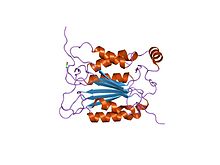Caspase
| Caspase domain | |||||||||
|---|---|---|---|---|---|---|---|---|---|

Structure of interleukin-1 beta-converting enzyme.
|
|||||||||
| Identifiers | |||||||||
| Symbol | Peptidase_C14 | ||||||||
| Pfam | PF00656 | ||||||||
| Pfam clan | CL0093 | ||||||||
| InterPro | IPR002398 | ||||||||
| PROSITE | PS50208 | ||||||||
| MEROPS | C14 | ||||||||
| SCOP | 1ice | ||||||||
| SUPERFAMILY | 1ice | ||||||||
|
|||||||||
| Available protein structures: | |
|---|---|
| Pfam | structures |
| PDB | RCSB PDB; PDBe; PDBj |
| PDBsum | structure summary |
Caspases (cysteine-aspartic proteases, cysteine aspartases or cysteine-dependent aspartate-directed proteases) are a family of protease enzymes playing essential roles in programmed cell death (including apoptosis, pyroptosis and necroptosis) and inflammation. They are named Caspases due to their specific cysteine protease activity - a cysteine in its active site nucleophilically attacks and cleaves a target protein only at the C-terminal of an aspartic acid amino acid. As of 2009, there are 11-12 confirmed Caspases in humans (since caspase-12 is a pseudogene in some individuals; Nature Medicine 11, 725 - 730 (2005)) and 10 in mice, carrying out a variety of cellular functions.
The role of these enzymes in programmed cell death was first identified in 1993, with their functions in apoptosis well characterised. This is a form of programmed cell death, occurring widely during development, and throughout life to maintain cell homeostasis. Activation of Caspases ensure that the cellular components are degraded in a controlled manner, carrying out cell death with minimal effect to surrounding tissues.
Caspases have other identified roles in programmed cell death such as Pyroptosis and Necroptosis. These forms of cell death are important for protecting an organism from stress signals and pathogenic attack. Caspases also have a role in inflammation, whereby it directly processes pro-inflammatory cytokines such as pro-IL1β. These are signalling molecules that allow recruitment of immune cells to an infected cell or tissue. There are other identified roles of caspases such as cell proliferation, tumour suppression, cell differentiation, neural development and axon guidance and ageing
...
Wikipedia
